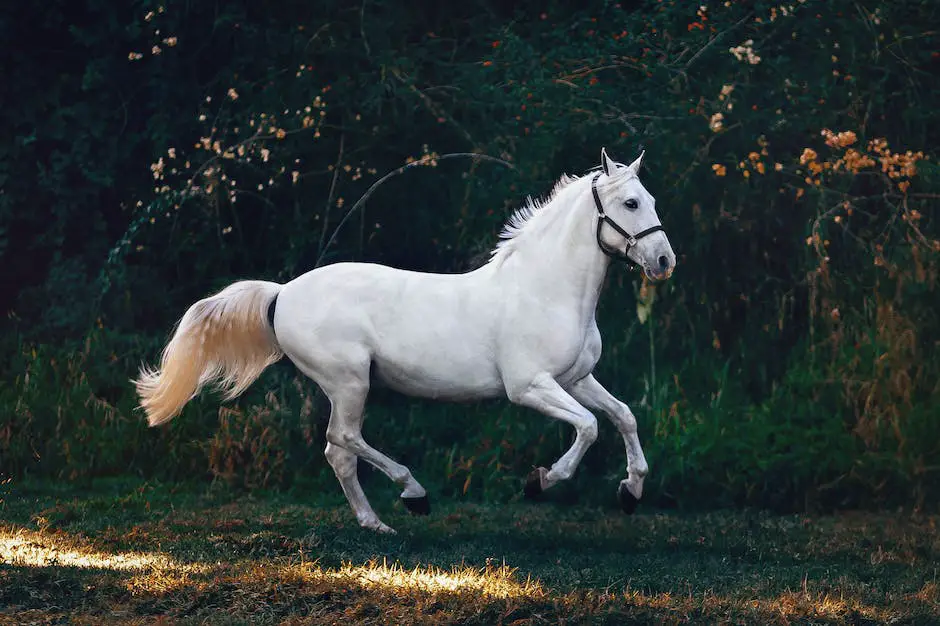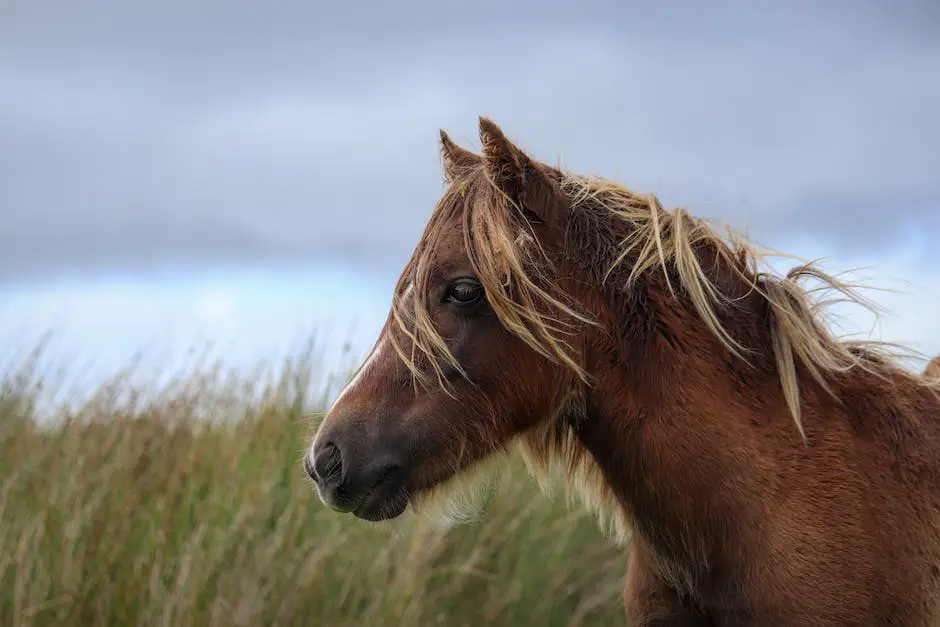Immerse yourself in the rich world of cold-blooded horses with our extensive exploration into their distinctive characteristics and special care requirements. As diverse and unique as any area of equine studies, understanding these magnificent creatures goes beyond simply recognizing them by their breed or physical attributes. Navigating the unique traits and physiological needs of these breeds not only fosters appreciation but also promotes their wellbeing. Giving focus to the academic, scientific, and practical aspects, we delve into the nuances of healthcare needs, balanced dietary requirements, ideal fitness regimen, and suitable handling and grooming methods that ensure their health, vitality, and all-round magnificence unfold in an optimum manner.
Table of Contents (Horspedia)
Understanding Cold-Blooded Horses: Basic Physiology and Taxonomy
The exploration of various horse breeds opens up an universe saturated with a myriad of fascinating differences and similarities.
One such fascinating differentiation is the classification of horses into “hot-blooded,” “warm-blooded,” and “cold-blooded” categories.
It’s worth remarking first and foremost that these categorizations are not analogous to the same terminology in biological parlance, such as the differentiation of reptiles as cold-blooded creatures.
In the equine context, these terms delineate temperament, size, and lineage demarcations among the various breeds.
Consequently, on this occasion, our investigative lens is focused squarely on the so-called “cold-blooded” horses.
Cold-blooded horses, though the term might evoke visions of horses unresponsive or insensitive to their environments, is rather a classification rooted in their lineage and physical attributes.
These horses typically hail from Northern Europe and are generally equated with what one would refer to as draft horses — breeds such as the Clydesdale, the Shire, or the Belgian.
What sets these majestic equine counterparts apart is their distinct physical attributes and personalities.
Physically, cold-blooded horses cut an imposing figure.
They exhibit larger dimensions than most of their cousins, often standing over 17 hands high and weighing in over 2000 pounds.
Apart from these measurements, they typically possess a stronger build, thicker bones, and more substantial muscle mass.
Their hooves and legs are robust, and their necks short and strong, meant to pull weight and do hard labor.
Their coat is thick and designed to withstand harsher colder climates, from whence they originated.
From a temperament perspective, these breeds trend toward the calm, dependable, and patient end of the equine disposition spectrum.
This makes them ideal for roles that require strength paired with steadiness, ranging from ploughing fields to pulling carriages, logging in forests to therapeutic riding programs for individuals with disabilities.
In observing the anatomical contrast between cold-blooded and other horses, one might initially overlook the substantial part these horses played in human history.
Draft or cold-blooded horses were integral to agricultural labor prior to the advent of mechanized machinery.
Their reliable, hardworking nature made them a prized asset for generations of farmers and laborers.
Before concluding this exploration of cold-blooded horses, it’s necessary to dispel any lingering myths that might inadvertently undervalue these gentle giants.
Their physical endurance and size do not preclude them from excelling in diverse tasks.
They continue to be endeared in modern societies, from their integral roles in rural communities to the spectacle of drum horses in royal processions.
In summary, the cold-blooded horse, with its notable physique and placid nature, holds a noteworthy position within the equine family, embodying both historical significance and contemporary appeal.
They are indeed gentle giants whose contributions continue to enrich our societies and captivate our imaginations.

Healthcare Needs for Cold-Blooded Horses
Veterinary Care for Specific Breeds of Horses: The Needs of the Cold-Blooded Breeds
Understanding the unique attributes and needs of cold-blooded horse breeds is central to providing appropriate and effective veterinary care. These breeds tend to bear extra weight, often exceeding the size of their warm and hot-blooded counterparts. This weight affects not only their size, shape, and aesthetic appearance, but also profoundly influences the types of health issues they are predisposed towards and the specialized care they require.
The cold-blooded breeds, such as the Clydesdale, Belgian, and Percheron, often require robust musculoskeletal care due to their distinctive heavy anatomy. With a dense structure and significant mass to carry, musculoskeletal strains, arthritis, and tendon injuries are often observed. Tailoring therapeutic strategies towards rehabilitation and pain management are critical components of veterinary care in these instances.
Similarly, the larger physical appearance of these breeds necessitates particular attention towards hoof health. The burden of the horse’s weight rests on their hooves, creating potential for serious hoof-related disorders like laminitis. Routine farrier care and examination should be ensured to maintain healthy hooves, while observing for signs of abnormalities.
Equine metabolic syndrome (EMS) is another health hazard that plagues cold-blooded horses due to their proclivity towards weight gain. This condition, similar to metabolic syndrome in humans, could trigger problems like insulin resistance, obesity, and increased risk of laminitis. By implementing targeted nutrition plans and regular exercise regimes, risks related to EMS can be curtailed.
The cold weather-resistant coat of these breeds, while beneficial in hardy climates, can contribute towards potential skin disorders. They may be more susceptible to rain scald or mud fever. Timely grooming and thorough skin checks can prevent these conditions from escalating and will contribute significantly to the horse’s overall health and well-being.
Dental health cannot be overlooked in the comprehensive healthcare plan for these breeds. With dental problems being exceedingly prevalent in horses, periodic oral examinations and routine dental care are of paramount importance.
The psychology of these breeds also plays into their health care. Their calm, dependable nature can make detection of subtle behavior changes linked to illness challenging. Keen observation on the horse’s demeanor, appetite, and regular behavior should assist in early illness identification.
Finally, preventative care such as vaccinations and deworming must not be neglected. Consistent immunization and regular deworming offer a bulwark against common infectious diseases and parasites, contributing to overall health and longevity.
Understanding the specific needs of these unique breeds is vital to ensuring they receive the most comprehensive and beneficial care. While their bulkier constructs and calm dispositions present distinctive challenges, with regular monitoring and preventative measures, cold-blooded horses can lead healthy, functional lives. In this way, the emphasis should always be on personalized treatment strategies founded on the understanding of each breed’s unique structural, physiological, and psychological characteristics. Countless lives can be effectively safeguarded by such an approach, enhancing both their welfare and our bond with these magnificent creatures.

Dietary Requirements and Fitness Regimen
Shaping A Balanced Diet For Cold-Blooded Horses
A balanced diet is a crucial component underpinning the sustainable health of cold-blooded horses. Their typical calm demeanor and minimal engagement in high intensity work means they have lower energy requirements than their hot-blooded counterparts. Consequently, a diet consisting primarily of forage, such as grass and hay, suffices in providing the needed calories. Moreover, a slow feeding approach assists in mimicking natural grazing habits, fostering a healthy digestive system. Trace minerals, vitamins, and salt, often neglected, should be supplemented as they play a crucial role in nerve function and muscle contractions among other physiological processes. However, due caution must be exercised to stave off obesity that could lure Equine Metabolic Syndrome, detrimental to their health.
Caring For The Musculoskeletal Structure Of Cold-Blooded Horses
Due to their heavy build, cold-blooded horses carry a significant load on their muscular and skeletal system. It necessitates adopting routines promoting the balanced distribution of this weight. Regular, moderate exercise complements this by ensuring muscle tone and joint mobility. Special attention should be paid to hooves, which bear the brunt of their massive weight. Periodic attention from a professional farrier can keep hoof-related disorders at bay.
Preventing Potential Health Disorders
Stable weight management is also paramount to prevent the onset of Equine Metabolic Syndrome (EMS), a recurring affliction among cold-blooded breeds due to their lower metabolic rate. An obese horse is a suitable prospect for EMS, a condition that can lead to laminitis, a painful inflammation in the hoof. A monitored diet combined with an appropriate exercise regime can ward off obesity effectively.
Grooming
Cold-weather breeds have dense skin to protect against harsh climates. Regular grooming not only augments their appearance but also promotes skin health by stimulating oil production for a healthy coat. Grooming can also prevent skin disorders by removing irritants that can cause inflammation or infection.
Dental Health And Behavioral Changes
Interestingly, changes in the behavior of a cold-blooded horse are often an indication of underlying health issues. Regular dental check-ups help detect problems before they morph into more severe conditions. Routine examinations and preventive care are thus suggested, with periodic vaccinations and de-worming playing a key role.
In summary, the care routine for cold-blooded horses goes beyond their diet, addressing their unique attributes that stem from their hefty yet sturdy build. Their weight management, hoof health, grooming, dental care, and psychology maintain their health. Close attention to their behavior changes can help detect potential illnesses early. Meticulous care based on knowledge of and respect for their unique characteristics not only enhances overall horse health, but also strengthens the bond between the horse and its handler.

Handling and Grooming for Cold-Blooded Horses
The proper handling and grooming of cold-blooded horses requires knowledge of their unique attributes and needs. It is essential to comprehend their massive body structure, slow metabolism, and the potential musculoskeletal issues that can ensue with these gentle giants. An understanding of their hoof health is also critical, since these horses are prone to certain hoof-related disorders due to their weight. Thus, regular inspections and professional farrier care are fundamental for maintaining hoof health.
Just as vital is the consideration of equine metabolic syndrome, a condition that cold-blooded horses can potentially develop due to their slow metabolism and predisposition toward weight gain. Implementing a weight management strategy for these equines, which could involve feed restrictions or a careful diet, is paramount.
Skin disorders are also common in cold-blooded horses, particularly given their thick, cold-resistant coats. Regular grooming, to remove excess hair and dirt, improves their coat’s health and appearance while helping to prevent skin conditions. The routine should involve brushing, bathing, and possibly body clipping during the sociable winter months.
In terms of dental health, cold-blooded horses ideally should undergo a dental check annually. Their teeth are particularly susceptible to abnormal wear and tear due to their diet, and any problems can adversely affect their health and well-being.
Unusual behavioral changes in these horses may signal illness. Cold-blooded horses are notoriously stoic often concealing pain or discomfort. Therefore, any change in behavior or routine may indicate a potential underlying health issue and requires immediate professional attention.
Preventative care is a crucial aspect of maintaining the health of cold-blooded horses. Annual vaccinations against common equine diseases, combined with a regular deworming schedule, offer maximum protection.
As bioindividuals, cold-blooded horses often respond differently to certain treatments and handling methods. Therefore, creating personalized treatment strategies catered to their unique needs is crucial for their well-being and can significantly enhance the bond between horse and handler.
Lastly, the diet of cold-blooded horses should be primarily forage-based, mimicking their natural grazing habits to satisfy their physiological and psychological needs. Particular attention should be paid to the prevention of obesity since these horses are efficient at utilizing their feed and tend to gain weight easily. This further emphasizes the importance of a carefully planned diet and moderate exercise routine to support musculoskeletal health, ensuring muscle tone, and joint mobility.
In conclusion, understanding the unique needs and attributes of cold-blooded horses is crucial for their care and management. With proper care, regular exercise, and a balanced diet, these equine gentle giants can lead healthy, prosperous lives.

Comparison: Cold-Blooded Horses and other Equine Species
As the substantial size, weight, build, and calm demeanor of cold-blooded horses have been documented, the focus now promptly shifts to the specific care needs pertaining to the welfare of these heavy-duty equines.
Cold-blooded horses, due to their distinct physical constitution, require specialized musculoskeletal care. More prone to physical stress, ongoing observation of movement during labor or exercise can identify signs of discomfort or underperformance. This enables early detection and intervention of conditions such as osteoarthritis, common in these heavy breeds. Fascinatingly, these horses’ hoof health also needs stringent surveillance due to their susceptibility to hoof-related disorders like laminitis, often associated with metabolic diseases or excessive weight bearing.
Speaking of weight, these equines are predisposed to Equine Metabolic Syndrome, a pathological condition characterized by insulin resistance, obesity, and laminitis. Therefore, stringent weight management strategies are necessary to prevent its onset.
These heavyweight horses have dense, cold-resistant coats, making them more susceptible to skin disorders. As such, regular grooming should not be overlooked. It aids in maintaining skin health, ensuring early detection of parasites, and averting potential skin diseases.
Dental health is another crucial aspect of cold-blooded horses’ wellbeing. Routine dental check-ups can efficiently avoid equine periodontal disease and other oral health-related complications, enhancing their overall quality of life. Fascinatingly, psychological and behavioral changes in these horses can indicate illness or discomfort; thus, understanding and monitoring equine behavior can serve as a valuable tool in preventive healthcare.
To prevent common equine diseases, vaccinations and deworming should be conducted regularly. A routine healthcare routine is vital in spotting potential health threats early and mitigating their impact. Since each horse is unique, personalized treatment strategies should be developed in consultation with a veterinarian, considering specific needs and conditions of individual cold-blooded horses.
Building upon their naturally calm and dependable nature, efforts to enhance the welfare and bond with these equine species should be encouraged. By addressing their unique attributes and needs, fostering a positive environment, and ensuring their physical wellbeing, a robust and trusted bond can be nurtured with these gentle giants of the equine world.
Cold-blooded horses, given their massive body structure, have higher energy requirements. Unlike their hot and warm-blooded counterparts, they thrive on a primarily forage-based diet with slow feeding methods that mimic natural grazing habits. However, due to their predisposition towards obesity, caution must be taken to avoid overfeeding. Supplementation with trace minerals, vitamins, and salt may be necessary, depending on individual deficiencies, diet type, and geographical location.
Remembering the horse’s origins roaming across vast landscapes, physical activity remains crucial, even for the hefty cold-blooded types. Regular, moderate exercise reinforces muscle tone, aids in weight control, and improves joint mobility – a splendid defense against musculoskeletal issues.
Overall, the successful care of cold-blooded horses hinges upon a keen understanding of their peculiar attributes, in-depth scientific knowledge of their specific needs, and the unceasing dedication to ensuring their highest attainable state of wellbeing. Attention to all aspects of their care will guarantee these noble, cold-blooded horses continue to serve humanity valiantly, be it in the field of agriculture, sports, therapy, or companionship.

Through an enlightening examination of the distinct attributes and needs of cold-blooded horses, this discourse provides enthusiasts and hobbyists an invaluable guide to effectively nurturing these equine treasure-troves. Highlighted throughout are the glaring and subtle contrasts with other horse breeds, offering a comparative perspective rooted in scientific research and academic discourse. The focus remains not just on recognizing such differences but channeling this understanding into effective care and handling methods. With this knowledge, you are not just enriching your experience as an enthusiast but contributing to the sustenance of these majestic breeds’ overall health and wellbeing.
